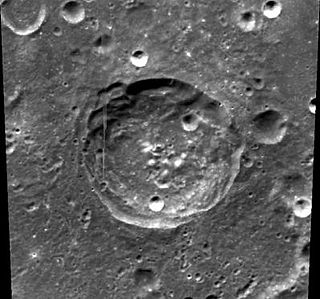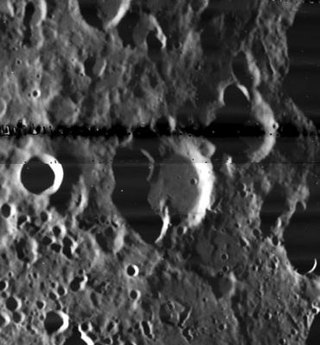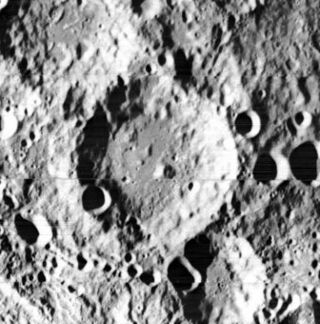
Cantor is a lunar impact crater that is located on the northern hemisphere on the far side of the Moon. The outer rim of the crater has a distinctly hexagonal shape, and is slightly longer in the north–south direction. The interior walls are multiply terraced, although less so along the western rim. There is a low central peak at the midpoint of the floor.

Atwood is a small earth moon impact crater that is located on the Mare Fecunditatis, to the northwest of the prominent crater Langrenus. It forms a triple-crater formation with Naonobu attached to the north rim and Bilharz near the west rim.

Fechner is a lunar impact crater that lies on the far side of the Moon's southern hemisphere, attached to the western rim of the large walled plain Planck. The eastern rim of Fechner intersects the Vallis Planck, a long, wide cleft in the surface that follows a course to the north-northwest. This valley intrudes into the southeastern rim of the crater, then continues northwards from the periphery of the northeast rim.

Chappell is a lunar impact crater on the far side of the Moon, in the northern hemisphere just to the north of the crater Debye. It is in a heavily bombarded section of the surface, and much of its outer rim is overlain by smaller craters. The northern rim in particular has been almost completely disintegrated, while small craters also overlie the rim to the northwest and southeast. What remains of the rim forms a rounded, somewhat irregular edge to the crater depression.

Stoney is an impact crater on the Moon, located in the southern part of its far side, approximately 47.5 kilometers in diameter. In 1970, it was named by IAU's Working Group for Planetary System Nomenclature after Anglo-Irish physicist George Johnstone Stoney (1826–1911). It lies to the southeast of the crater Baldet and to the east of Bhabha.

Chaplygin is a large lunar impact crater that lies on the far side of the Moon. It is located to the southeast of the huge walled plain Mendeleev, about midway between the craters Schliemann to the northeast and Marconi to the southwest. It is about the same size as Albategnius on the near side.

Cockcroft is a lunar impact crater that is situated on the far side of the Moon from the Earth, so that it has only been observed and photographed from orbit. It lies to the northeast of the larger crater Fitzgerald, and southeast of Evershed.

Chappe is a lunar impact crater that lies along the southwestern limb of the Moon. It is nearly attached to the northern limb of the walled plain Hausen, and an equal distance from the crater Pilâtre. To the north-northwest is Blanchard.

Douglass is a lunar impact crater on the far side of the Moon. It lies to the southwest of the crater Frost and south-southwest of the large walled plain Landau.

Dante is a lunar impact crater that is located on the far side of the Moon. It lies in the northern hemisphere exactly opposite the prime meridian facing the Earth. The nearest craters of note are Larmor to the north and Morse to the southeast. To the southwest is the oddly shaped Buys-Ballot.

Delporte is a lunar impact crater on the far side of the Moon. It overlies part of the northwestern rim of the huge walled plain Fermi, and the crater Litke is nearly attached to the southeastern rim.

Florensky is a lunar impact crater that is attached to the northeastern rim of the larger crater Vernadskiy. It is located on the far side of the Moon and cannot be directly seen from the Earth. The rim of this crater has been heavily eroded and it forms an irregular ring about the uneven interior. This crater was previously identified as Vernadskiy B before being assigned a name by the IAU in 1985.

Helberg is a lunar impact crater that is located just behind the western limb of the Moon, on the far side from the Earth. Due to libration this part of the surface is sometimes brought into view, and the crater is visible under suitable lighting conditions. However even under these circumstances the crater is viewed from the edge and not much detail can be seen.

Hogg is a lunar impact crater on the Moon's far side. It lies less than a crater diameter to the south-southwest of the somewhat larger Kidinnu. This is an old, worn feature with an outer rim that has been eroded to the point where it just forms a rounded crest about the interior. Small craterlets lie along the southern and western rim. The interior has some slight clefts in the surface and a low, crater-like depression in the southern half.

Trumpler is a lunar impact crater on the far side of the Moon. It was named by the IAU in 1970 after Swiss-American astronomer Robert Julius Trumpler (1886–1956). It lies just to the south of the crater Nušl, and northwest of Freundlich. To the southwest is the heavily battered crater Tikhomirov.

Szilard is a damaged lunar impact crater that lies to the east-northeast of the crater Richardson. It is named after Leó Szilárd, the scientist who theorised nuclear chain reactions and famously worked on the atomic bomb during World War II. About a half-crater-diameter to the northwest is the large walled plain Harkhebi. Between Harkhebi and Szilard is the small Giordano Bruno. The ray system from this impact forms streaks across the rim and interior of Szilard.

Wood is a lunar impact crater that lies entirely within the interior of the much larger walled plain Landau, on the far side of Moon. Wood is situated along the northwestern part of the floor of Landau, and shares a common northwestern rim with the larger impact. The inner wall of the northwest rim extends inward about halfway toward the crater midpoint, where there is a central peak. The rim of Wood is somewhat worn and uneven, with a small crater laid across the southwest section. The surviving interior floor is nearly level and is marked only by a few small craters.

Lane is a lunar impact crater. It lies on the far side of the Moon, just to the west of the crater Ten Bruggencate. To the west of Lane is Perepelkin, and to the northwest lies Love.

Röntgen is a relatively large lunar impact crater that lies along the northwestern limb of the Moon. Its northwestern outer rim is partly overlain by the crater Nernst. Both Nernst and Röntgen overlie the eastern rim of the much larger walled plain Lorentz. The smaller crater Aston is separated from the eastern edge of Röntgen by only a few kilometers of terrain. To the south-southeast is Voskresenskiy.

Stratton is a lunar impact crater on the Moon's far side. It is located to the north of the large craters Keeler and Heaviside, and less than one crater diameter to the south of Dewar.





















